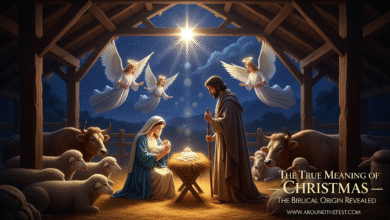Why Canada and US Thanksgiving Are Different? Explained
Introduction: Why Canada and US Thanksgiving Are Different
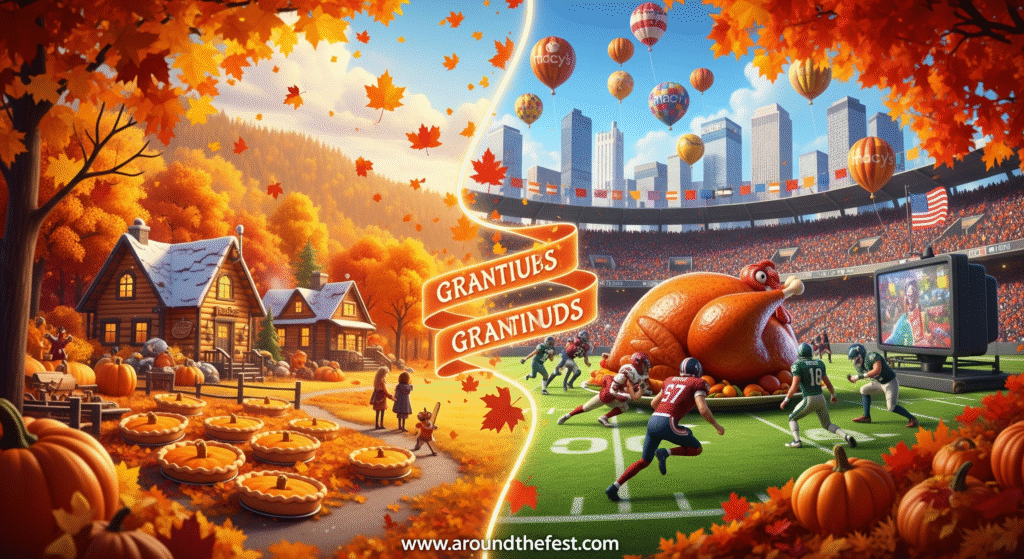
Why Canada and US Thanksgiving Are Different is a question many people ask when they notice the similar yet distinct celebrations in both countries.
While Canadians and Americans both honor gratitude, family, and harvests, the origins, timing, foods, and cultural traditions of their holidays differ in fascinating ways.
Understanding these differences reveals more than just dates on the calendar—it shows how history, geography, and culture shape the way a society celebrates, and how communities adapt these traditions over time to reflect changing lifestyles and values.
These variations also highlight how each nation interprets gratitude, incorporates seasonal foods, and maintains traditions that resonate with their unique histories.
Canadian Thanksgiving (1578 – Present)
1.Traces back to 1578, when explorer Martin Frobisher gave thanks for surviving a dangerous Atlantic voyage.
2.Indigenous harvest festivals significantly influenced early Canadian celebrations, introducing:
• Local foods
• Rituals
• Seasonal customs still part of modern gatherings
3. Became official in 1957, emphasizing gratitude for the harvest rather than historical events.
4. Modern celebrations include:
• Cozy family meals
• Seasonal pies
• Community festivals
5. Blends centuries-old traditions with contemporary practices.
American Thanksgiving (1621 – Present)
1. Rooted in the 1621 feast shared between Pilgrims and Native Americans in Plymouth, Massachusetts.
2. Declared a national holiday in 1863 by President Abraham Lincoln during the Civil War to unify the nation.
3. Evolved traditions include:
• Large-scale parades
• Football games
• Black Friday shopping
• Elaborate family feasts.
4. Created a distinctly American cultural experience.
Modern Trends in Both Countries
1.Both holidays continue to evolve with time.
2.Modern celebrations often include:
• Friendsgiving gatherings
• Multicultural menus
• Eco-friendly practices, reflecting:
Contemporary values
Inclusivity
Sustainability
3. Despite differences, the core message of gratitude and togetherness remains central to both Canada and U.S. traditions.
In this article, we will explore why Canada and US Thanksgiving are different in every aspect:
- History
- Dates
- Traditional foods
- Cultural practices
- Modern trends
- Fun facts
Providing a complete and engaging guide for readers.
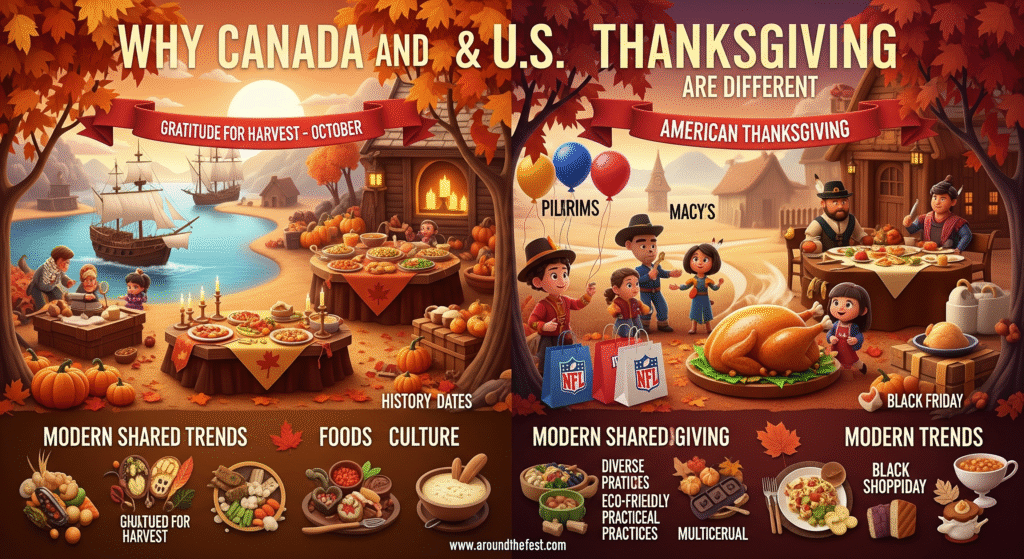
Historical Origins: Why Canada and US Thanksgiving Are Different
Canadian Thanksgiving Origins
1.1578: Explorer Martin Frobisher gave thanks for surviving the Atlantic voyage.
2. Indigenous Harvest Influence:
Seasonal foods
Traditional rituals
Community-based celebrations
3. Official Holiday: Declared by Canadian Parliament in 1957.
4. Focus: Gratitude for the harvest rather than historical events.
5. Modern Practices:
Family meals
Seasonal pies and desserts
Community and provincial festivals
American Thanksgiving Origins
1.1621: Rooted in a shared feast between Pilgrims and Native Americans in Plymouth, Massachusetts.
2. National Holiday: Proclaimed in 1863 by President Abraham Lincoln during the Civil War.
3. Focus: Celebrates survival, unity, and gratitude.
4. Evolved Traditions:
Family feasts
Parades (e.g., Macy’s Thanksgiving Day Parade)
Football games
Early Black Friday shopping
Key Historical Differences: Why Canada and US Thanksgiving Are Different
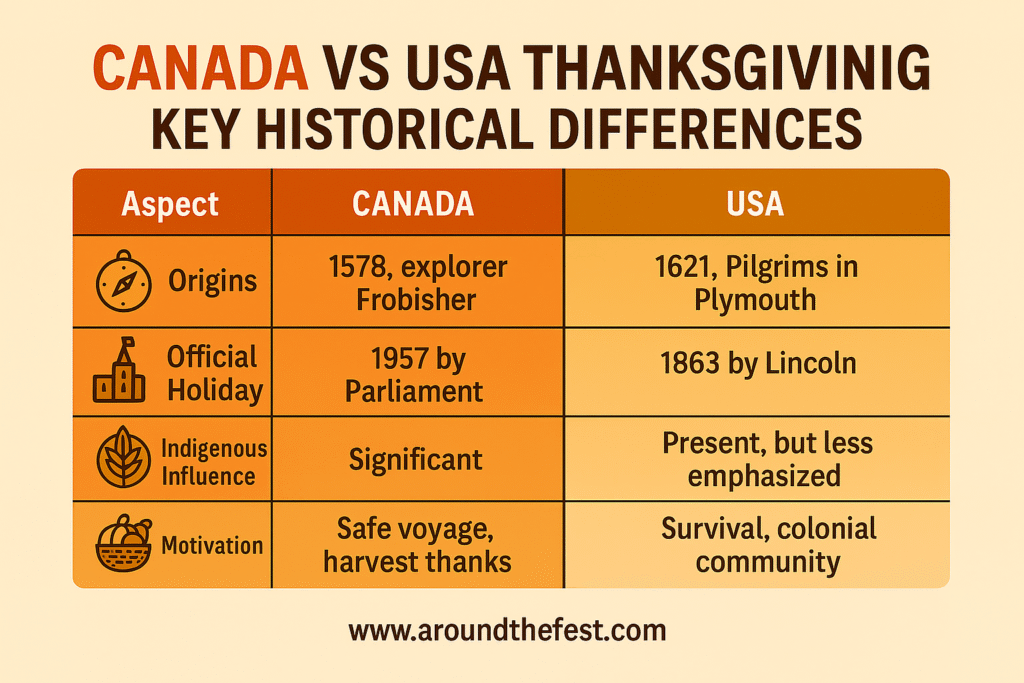
Canada: Emphasizes harvest and seasonal celebration.
USA: Emphasizes historical survival and national unity.
These roots explain why Canada and US Thanksgiving are different today.
Dates & Seasonal Context: Why Canada and US Thanksgiving Are Different
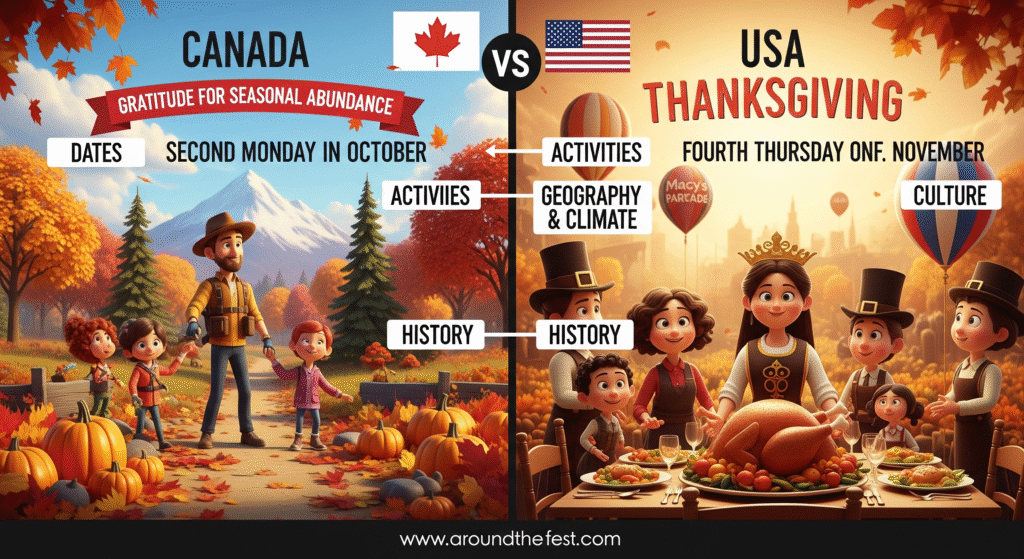
Canadian Thanksgiving Date & Season
When: Celebrated on the second Monday in October.
Why: Aligns with Canada’s earlier northern harvest season.
Typical Activities:
1. Outdoor gatherings and nature trips
2. Provincial harvest festivals
3. Cozy family meals
Theme: Gratitude for seasonal abundance.
US Thanksgiving Date & Season
When: Celebrated on the fourth Thursday in November.
Why: Reflects Pilgrim harvest traditions and colonial history.
Typical Activities:
1. Large family feasts
2. Macy’s Thanksgiving Day Parade
3. Football games
4. Start of Black Friday shopping
Theme: Blends history, gratitude, and modern celebrations.
Why the Dates Differ: Key Context
1. Geography & Climate:
Canada’s harvest comes earlier.
US harvest is later in the year.
2. Historical Traditions:
Canada: explorer gratitude + harvest customs.
USA: Pilgrim survival + colonial unity.
3. Cultural Preferences:
Canada: enjoys long October weekend.
USA: emphasizes late-November family gatherings.
Takeaway:
Understanding dates and seasonal context helps explain why Canada and US Thanksgiving are different, even though both share the core message of gratitude.
Feast Comparison: Why Canada and US Thanksgiving Are Different
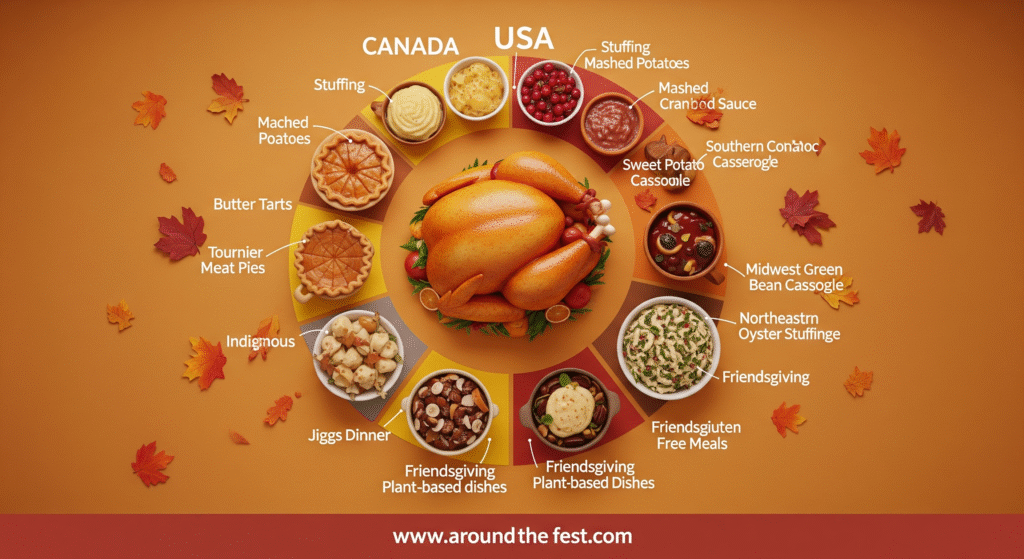
Canadian Thanksgiving Menu
1.Classic Staples
• Roast turkey with stuffing and rich gravy
• Fluffy mashed potatoes
• Homemade cranberry sauce
• Spiced pumpkin pie
2. Regional & Cultural Touches
• Butter tarts – a sweet pastry beloved across Ontario
• Tournier – a savory meat pie from Quebec traditions
• Jiggs dinner – boiled meat, potatoes, and vegetables, especially popular in Newfoundland and Labrador
3. Indigenous & Seasonal Roots
• Dishes featuring wild game, corn, beans, and squash (“the Three Sisters”)
• Hearty root vegetables like turnips and carrots
• Menus often shaped by Canada’s multicultural mix — from South Asian curries to Caribbean flavors
4. Modern Dining Trends
• Friendsgiving potluck meals with shared dishes
• Plant-based twists on classics, including lentil loafs, vegan gravies, and dairy-free pies
American Thanksgiving Menu
1.Classic Staples
• Roast turkey with stuffing and gravy
• Mashed potatoes with butter or cream
• Cranberry sauce
• Sweet potato casserole topped with marshmallows
• Pumpkin pie as the holiday dessert essential
2. Regional Flavor Profiles
• Southern tables: cornbread, collard greens, macaroni and cheese
• Midwestern homes: green bean casserole, sweet corn dishes
• Northeastern menus: oyster stuffing, cranberry relish variations
3. Cultural & Modern Influences
• Immigrant family traditions bring dishes like Italian pasta salads, Mexican tamales, and Asian-inspired stir-fries to the table
• Friendsgiving parties often feature fusion dishes and creative takes on side dishes
• Gluten-free, vegan, and plant-based meals are becoming increasingly mainstream
Canadian Thanksgiving: rooted in harvest traditions, with comfort-food classics, regional specialties, and Indigenous influences shaping the menu.
American Thanksgiving: celebrated with bigger feasts, more regional variety, and evolving modern trends that embrace global flavors.
Shared centerpiece: Turkey remains the unifying star, but it’s the side dishes, desserts, and cultural adaptations that truly set the two holidays apart.
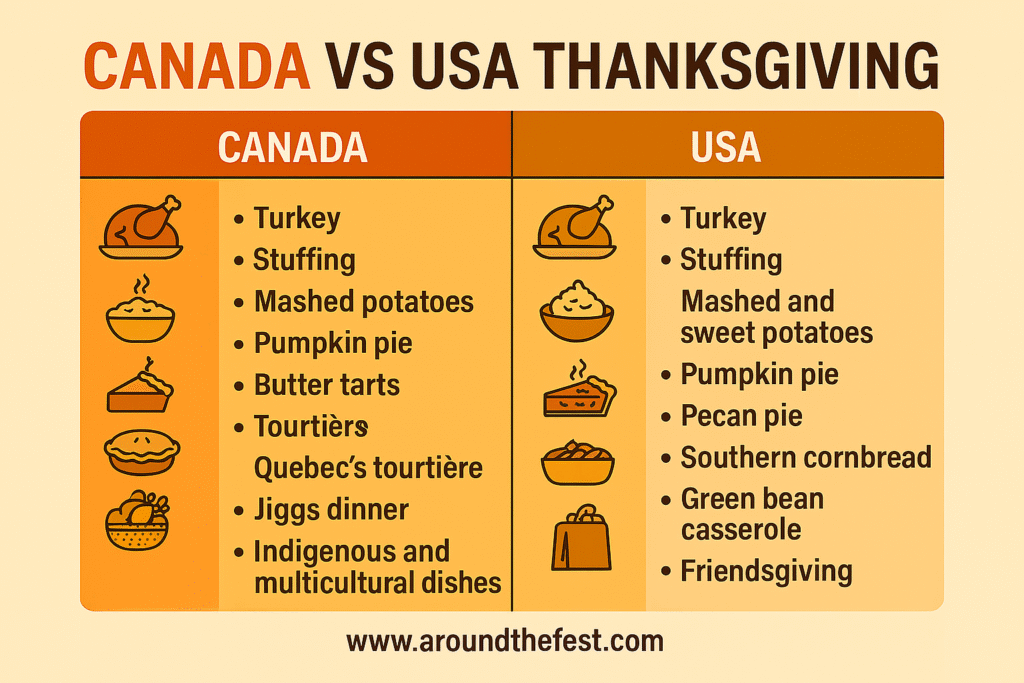
Traditions & Celebrations: Why Canada and U.S. Thanksgiving Feel Different
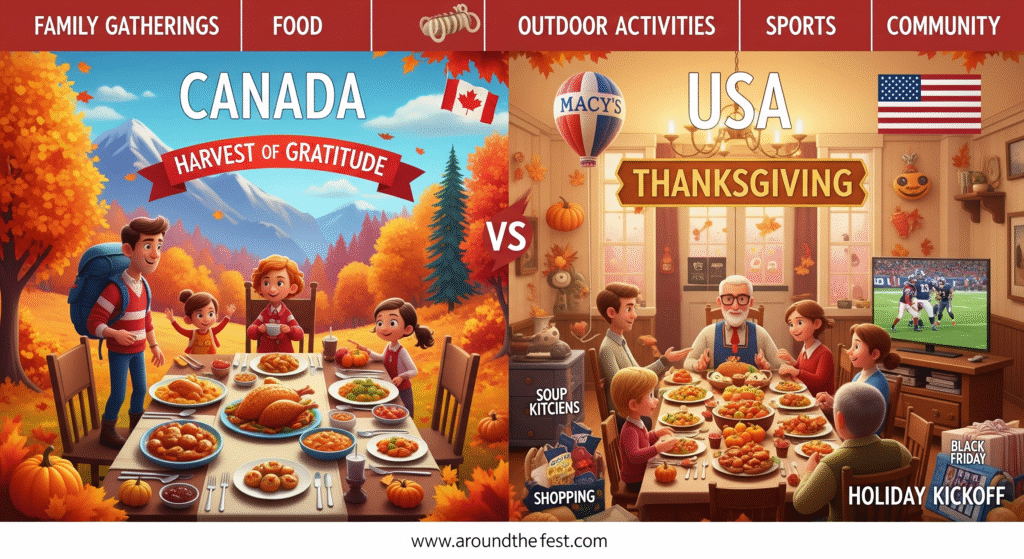
Food might be the centerpiece on both sides of the border, but the overall vibe, traditions, and cultural meaning of Thanksgiving in Canada versus the United States tell two very different stories.
Canadian Thanksgiving Traditions
Family-Centered Gatherings – Canadian Thanksgiving tends to be more relaxed and intimate. Most families celebrate with a cozy meal at home or a simple get-together with close relatives.
Harvest of Gratitude – Tied closely to the fall harvest, many communities in Canada emphasize thankfulness for nature’s abundance. Church services and local community dinners remain a tradition in rural towns.
Enjoying the Outdoors – Since Thanksgiving in Canada happens in early October, the weather is still perfect for autumn activities. Hiking, admiring fall foliage, or spending weekends at a cottage are popular choices.
Sports & Pastimes – CFL (Canadian Football League) games play during the holiday weekend, though football doesn’t dominate Canadian Thanksgiving the way it does in the U.S.
Cultural Fusion at the Table – Reflecting Canada’s diversity, it’s common to see traditional turkey alongside international flavors—everything from butter chicken to dumplings.
American Thanksgiving Traditions
The Grand Feast – U.S. Thanksgiving is famous for its big family reunions, where extended relatives often travel long distances to gather around the table.
The Macy’s Parade – The annual Macy’s Thanksgiving Day Parade in New York City has become an iconic tradition, drawing over 20 million viewers on TV each year.
Football Obsession –“Thanksgiving isn’t just about turkey and pumpkin pie—it’s also about football. NFL games have become a holiday staple, with millions of Americans tuning in each year. For many families, watching football together is just as much a tradition as the feast itself.”
Giving Back – Acts of service play a huge role, with soup kitchens, food banks, and nonprofits seeing their highest levels of donations and volunteer support during Thanksgiving week.
Holiday Season Kickoff – Unlike in Canada, U.S. Thanksgiving serves as the gateway to Christmas festivities. Black Friday shopping kicks off right after the feast, marking the start of the holiday rush.
The Big Takeaway
Canadian Thanksgiving feels like a harvest-inspired, intimate holiday rooted in gratitude and seasonal traditions.
In contrast, American Thanksgiving has evolved into a grand national celebration that blends food, family, parades, football, volunteering, and consumer culture.
Modern Trends and Evolving Traditions: Why Canada and US Thanksgiving Are Different
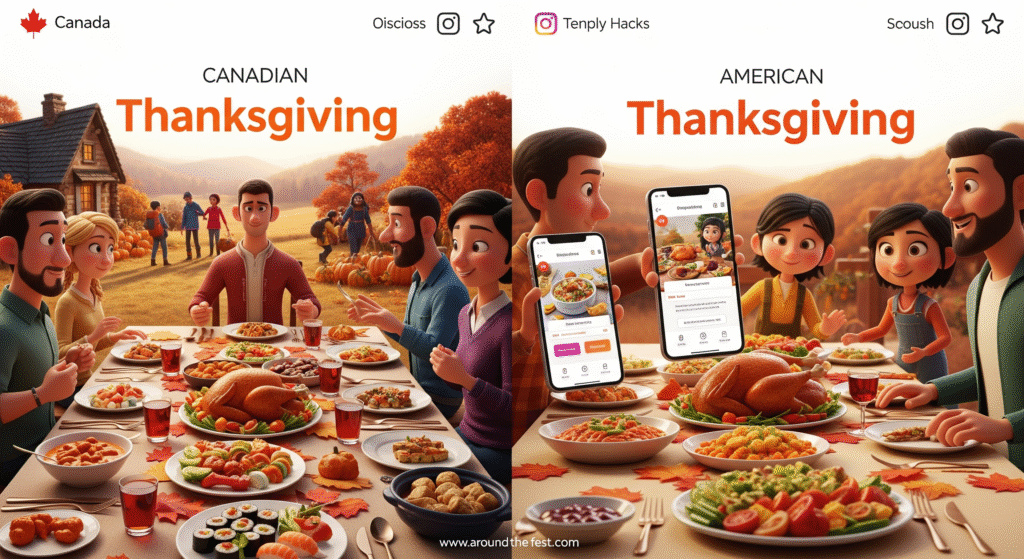
While the core message of gratitude remains, Thanksgiving in 2025 has evolved in both Canada and the United States. Modern lifestyles, diverse communities, and social media influence how people celebrate today.
Canadian Thanksgiving: Contemporary Practices
Friendsgiving Gatherings – Many Canadians now celebrate with friends in addition to family, creating more flexible and social holiday experiences. Surveys suggest over 30% of young Canadians now host or attend a Friendsgiving event.
Multicultural Menus – Traditional turkey and pie coexist with international dishes such as butter chicken, sushi platters, or Mediterranean-inspired sides, reflecting Canada’s diversity. Popular fusion dishes include maple-glazed tofu, curry pumpkin soup, and perogies alongside roast turkey.
Eco-Friendly Practices – Families increasingly embrace sustainable options, like using local produce, composting leftovers, or choosing reusable tableware. Reusable table settings and biodegradable plates are becoming trendy in urban areas.
Outdoor Activities – Early October allows for fall hikes, pumpkin-picking, and cozy cottage weekends as part of modern celebrations. Some communities organize harvest-themed fun runs or pumpkin festivals.
Community Involvement – Local fairs, harvest festivals, and charitable activities remain popular, blending traditional and modern practices. Food drives and volunteer hours spike during this weekend in rural and urban regions alike.
American Thanksgiving: Contemporary Practices
Friendsgiving and Fusion Feasts – U.S. households are increasingly hosting multiple dinners, including Friendsgiving events with international or fusion dishes. Popular dishes include kimchi stuffing, Mexican tamales, and curry-spiced vegetables alongside classic turkey.
Dietary Adaptations – Vegan, vegetarian, gluten-free, and plant-based alternatives are now common on many Thanksgiving tables. Reports indicate nearly 25% of American households include at least one plant-based dish.
Media Influence – social media, streaming shows, and televised parades have reshaped how people engage with the holiday. Recipes, DIY décor, and holiday hacks frequently trend on TikTok, Instagram, and YouTube, influencing millions of viewers.
Sustainability Trends – Some Americans are adopting zero-waste practices, local sourcing, and eco-conscious tableware. Popular strategies include composting scraps, sourcing from local farms, and avoiding single-use plastics.
Cultural Blending – Immigrant cuisines and global flavors (curry vegetables, tamales, Asian-inspired sides) are increasingly part of Thanksgiving feasts. Fusion dishes like sushi stuffing or Ethiopian pumpkin stew are now regular additions in metropolitan areas.
Takeaway
While Canada emphasizes harvest, family, and local culture.
U.S. blends celebration, media, and global culinary trends, making each country’s Thanksgiving unique.
Fun Facts & Lesser-Known Trivia: Why Canada and US Thanksgiving Are Different
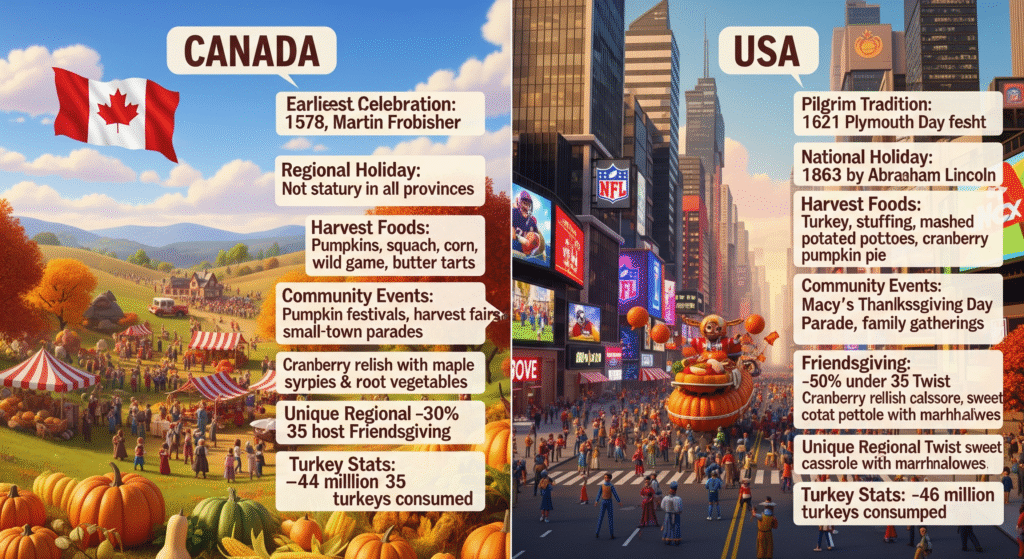
Even though both Canadians and Americans celebrate Thanksgiving, there are plenty of little-known facts, surprising statistics, and quirky traditions that make each holiday unique.
Canadian Thanksgiving: Fun Facts
Not a Statutory Holiday Everywhere – Thanksgiving is observed as a public holiday in most provinces, but not in Prince Edward Island or some northern territories, giving it a more regional feel.
Earliest Official Celebration – The first Thanksgiving in Canada dates to 1578 with explorer Martin Frobisher, making it older than the U.S. version.
Harvest-Focused Foods – Many Canadians celebrate with pumpkins, squash, corn, wild game, and region-specific dishes like butter tarts and torchière.
Community Events – Small towns host pumpkin festivals, harvest fairs, and parades, which remain a key part of local traditions.
Friendsgiving Trend – Around 30% of Canadians under 35 now host Friendsgiving-style gatherings, adding a social twist to the holiday.
Unique Regional Twist – Some provinces include cranberry relish with maple syrup or incorporate local berries and root vegetables in their meals.
Turkey Stats – Canadians consume roughly 9 million turkeys during Thanksgiving week, about one-quarter of U.S. holiday consumption.
American Thanksgiving: Fun Facts
Pilgrim Tradition – The 1621 Plymouth feast is widely regarded as the first Thanksgiving, though similar harvest celebrations existed in other colonies.
Official National Holiday – Declared in 1863 by Abraham Lincoln to unify the nation during the Civil War.
Massive Travel Weekend – Thanksgiving is the busiest travel period in the U.S., with over 55 million Americans flying or driving to visit family.
Turkey Pardoning – Each year, the President officially pardons a turkey, a quirky White House tradition since 1947.
Cultural Extravaganza – From the Macy’s Parade to NFL games and Black Friday shopping, American Thanksgiving blends tradition, entertainment, and consumer culture.
Dietary & Fusion Trends – Many households now serve fusion dishes like kimchi stuffing, curry vegetables, or Mexican tamales.
Turkey Stats – Approximately 46 million turkeys are consumed in the U.S. each Thanksgiving, with regional variations in sides and desserts.
These fun facts highlight why Canada and US Thanksgiving are different: from dates and history to foods, parades, and quirky customs. Whether it’s the smaller harvest celebrations in Canada or the grandiose, nationally televised events in the U.S., each country has its own unique way of giving thanks.
Why Canada and US Thanksgiving Are Different-Why the Differences Matter?
Understanding the differences between Canada and US Thanksgiving is more than a fun comparison—it reveals how history, geography, culture, and modern lifestyles shape national celebrations.
Historical & Cultural Significance
• Canada: Thanksgiving emphasizes harvest gratitude, community celebrations, and regional traditions. The earlier October date aligns with the northern harvest season, giving Canadians a reflective, cozy, and family-focused holiday.
• USA: Thanksgiving celebrates Pilgrim survival, unity, and national heritage. The late November date coincides with the traditional harvest period in New England and has evolved into a larger cultural phenomenon with parades, sports, and commerce.
Culinary Implications
• Canada: Foods highlight seasonal abundance, including turkey, butter tarts, tourtière, and Indigenous-inspired dishes. Multicultural influences are present but subtly integrated.
• USA: Thanksgiving menus are expansive, blending regional specialties, immigrant cuisines, and modern dietary trends. Side dishes, desserts, and fusion recipes create a vibrant culinary experience.
Modern Trends & Social Impact
• Friendsgiving and Multicultural Menus: Both countries are embracing social gatherings with friends and culturally diverse dishes.
• Eco-Friendly Practices: Sustainable celebrations, zero-waste approaches, and local sourcing reflect contemporary values.
• Media & Technology: Social media, streaming content, and viral recipes influence how Americans and Canadians prepare, share, and celebrate the holiday.
Key Takeaways
• Timing: October vs. November reflects geography, harvest cycles, and historical events.
• Scale: Canadian celebrations are intimate, while U.S. festivities are grand and nationally broadcasted.
• Traditions: Canada emphasizes harvest and family, while the U.S. blends history, entertainment, and commercial culture.
• Food: Turkey remains the centerpiece, but side dishes, desserts, and fusion menus reflect regional and modern adaptations.
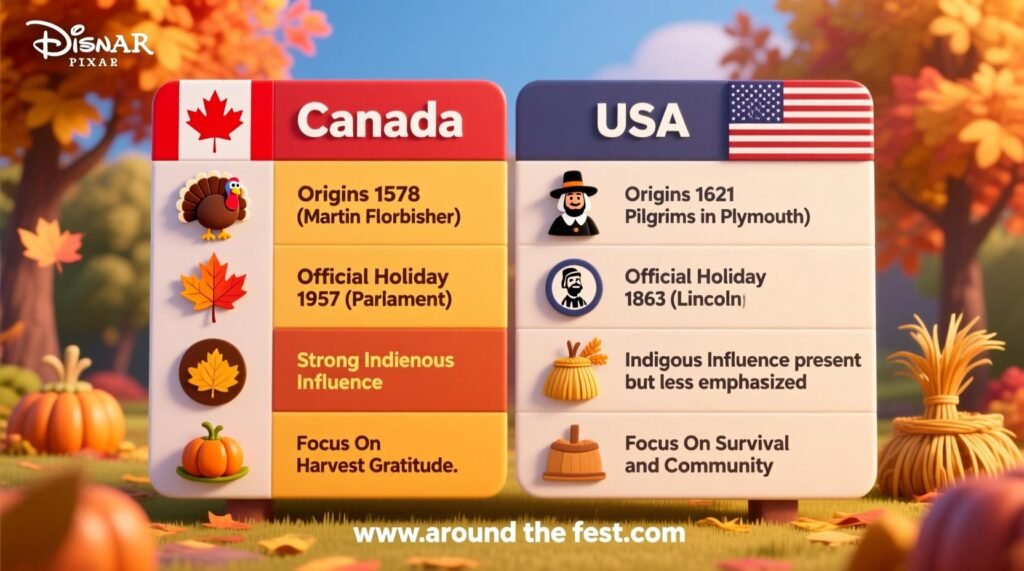
Conclusion: Why Canada and US Thanksgiving Are Different
So, why are Canada and US Thanksgiving different? It’s more than just dates on the calendar. Canadian Thanksgiving is cozy, harvest-focused, and family-centered, celebrating seasonal abundance and community. In contrast, U.S. Thanksgiving is grand, festive, and culturally diverse, blending historical traditions, parades, football, and massive feasts.
Understanding these differences lets us appreciate unique cultural perspectives and inspires fresh ways to celebrate. Why not try a Canadian butter tart alongside your pumpkin pie or host a Friendsgiving featuring dishes from both countries?
At its heart, Thanksgiving—whether in October or November—reminds us of gratitude, togetherness, and shared traditions. By exploring both celebrations, you can create a richer, more meaningful holiday experience.
Tip: Snap a visual comparison of your table this year—it’s a fun way to capture why Canada and US Thanksgiving are different!
🇨🇦 Canadian vs. 🇺🇸 American Thanksgiving: FAQs
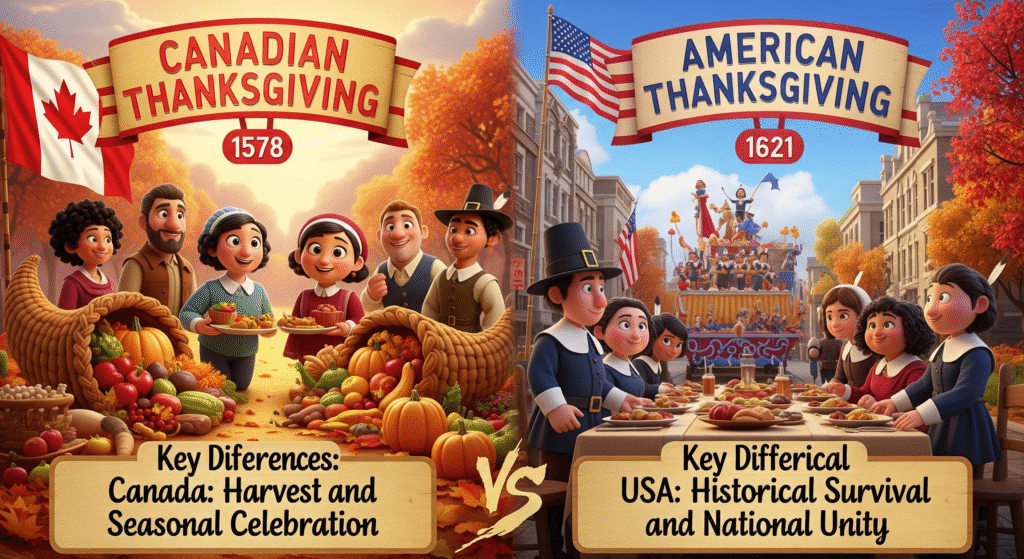
Q1. When is Canadian Thanksgiving celebrated?
Ans. Canadian Thanksgiving takes place on the second Monday of October, coinciding with the northern harvest season. This timing makes it ideal for outdoor activities and family gatherings.
Q2. When is American Thanksgiving celebrated?
Ans. In the United States, Thanksgiving is observed on the fourth Thursday of November, a date officially established by Congress in 1941 to ensure a consistent national holiday.
Q3. Why do Canada and the U.S. celebrate Thanksgiving on different dates?
Ans. The difference in dates reflects historical and agricultural factors. Canada’s earlier Thanksgiving aligns with its shorter growing season, while the U.S. date is tied to Pilgrim traditions and later harvest timing.
Q4. What are the main differences in Thanksgiving traditions between Canada and the U.S.?
Ans. Canadian Thanksgiving is typically more intimate and family-focused, centered on the harvest. U.S. Thanksgiving, however, features larger gatherings, parades, sports, and nationwide festivities.
Q5. Is Thanksgiving a statutory holiday in both countries?
Ans. In Canada, Thanksgiving is a statutory holiday in most provinces, though a few regions do not officially observe it. In the U.S., Thanksgiving is a federal holiday observed across all states.
Q6. How do Canadians and Americans typically spend Thanksgiving Day?
Ans. Canadians enjoy family meals and outdoor activities, such as hikes or harvest festivals. Americans usually celebrate with large family gatherings, watching parades, and football games.
Q7. Are there any unique Thanksgiving traditions in Canada or the U.S.?
Ans. Canada features unique dishes like Jiggs’ dinner and butter tarts. The U.S. is known for iconic events like the Macy’s Thanksgiving Day Parade in New York City.





